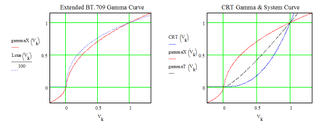Understanding Gamma and High Dynamic Range: Part 1

In order to fully understand high dynamic range (HDR) video it’s necessary to understand gamma. We have all heard about gamma since the early days of television, but now as the industry moves to HDR content production and delivery, gamma still plays an important role. In this two-part series, I first start by taking a look at some misconceptions about gamma. Here are several common ones I hear frequently.
Gamma is nothing more than a cathode ray tube defect – Gamma is caused by the voltage to current grid-drive of the CRT and not the phosphor. Consequently, a current-driven CRT cathode has a substantially linear light response. This means gamma could have been removed even in the glory days of CRT.
Gamma is required to match human visual response – A common belief is that a non-linear Optical to Electrical Transfer Function is needed because of the non-linearity of the human visual system. It is true that the human visual system is very complex and lightness perception is non-linear, approximating to a cube-root power law. If a television system such as a camera, transmission system and display can faithfully reproduce the light from the scene the camera is pointed at, then the manner in which humans see light shouldn’t make any difference.
Related: Vizio Firmware Upgrade Brings HDR 10 to 4K Sets
Gamma can always be accurately adjusted – When set properly, a studio reference monitor should comply with ITU-R BT.1886 with a gamma exponent of 2.4. However, effective gamma still changes with brightness-control (black-level) or room lighting. Black levels can track room lighting with auto-brightness (began in early 1970s) to roughly maintain gamma.
Gamma is fixed or burnt into flat panels – Effective gamma and display black levels change based on room lighting. The power-law equation, where the light output is related to the drive voltage raised to a fixed exponent, is sometimes referred to as gamma meaning the gamma function. Other times, we simply mean the exponent itself such as 2.2 or 2.4. Flat panel monitors must match the power-law gamma Electrical to Optical Transfer Function (EOTF) but, since it is not native to the display technology, it must be created with signal processing such as with a look up table or LUT. Note that brightness adjustments will change effective gamma.
With today’s technology why not get rid of the gamma power law? – Occasionally, it is suggested that with programmable LUTs in modern displays we could easily get rid of gamma. Modern cameras have many gamma, log or custom Optical to Electrical Transfer Function (OETF) settings beyond the standardized BT.709 camera gamma setting. They vary with manufacturer and most even have custom settings or modifications to a fixed log or power-law OETF to allow artistic changes or compensate for scene lighting at image capture. The imaging system’s dynamic range on some cameras is now very large so the OETF needs to have some kind of non-linear log or power-law setting to compress the range to a 12 or 10 bit RGB output. Thus, to even get the imager signal out of the camera without the need for 16 or more bits of processing, it is not possible to get rid of gamma and go to a linear OETF.
To build on the last point, as can you can see in the plot on the left in Figure 1, legacy BT.709 gamma is very similar to how humans perceive light. The blue trace represents roughly the cube-root of light perception although there are many, much more complicated, expressions that better model this complex process. From a big picture perspective, it’s fortunate that the inverse of CRT gamma curve nearly matches perceptual lightness response, meaning pre-corrected camera output is close to being perceptually coded. If early displays had a linear response, early TV designers would have invented a gamma-like function anyway and added it to all display technologies from the beginning. To some degree, the industry lucked out since CRTs forced the camera gamma that became BT.709.
The graph on the right of Figure 1 shows camera BT.709 gamma vs. BT.1886 or CRT display gamma. Since they are not quite the inverses of each other, system gamma ends up being slightly greater than one to about 1.2 as shown in the black trace. This is acceptable since it compensates for the typical dark surrounding of viewing conditions and makes the image seem to have higher dynamic range. The effect is a stretching of the dark grays near black so what you see on the display is not exactly what you see looking at the actual scene.
Figure 1. Camera and display gamma curves.
In the second part of this two-part series on gamma and capturing and displaying HDR content to come, we take a look at evolving HDR standards and offer tips on using a waveform monitor to adjust HDR gamma.
Educated in England where he received an Honors degree in Communications Engineering from the University of Kent, Mike Waidson started his career with a consumer television manufacturer as a research engineer in the digital video department, before moving into the broadcast industry. Mike has over 30 years of experience within the broadcast industry working for various video manufacturers. At Tektronix as an application engineer within the Video Business Division, Mike provides technical support on video measurement products.
Broadcasting & Cable Newsletter
The smarter way to stay on top of broadcasting and cable industry. Sign up below
